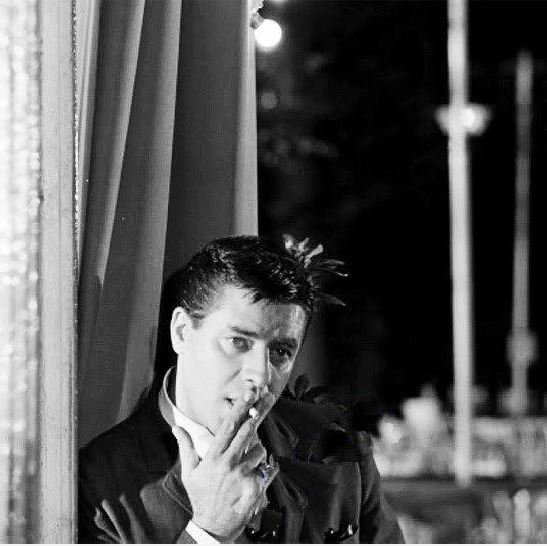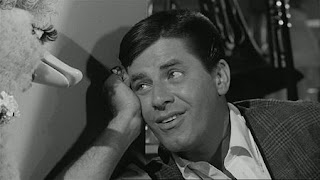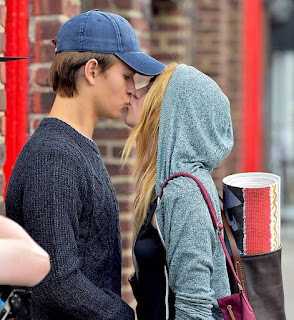Turner Classic Movies pays tribute to Jerry Lewis on Monday, September 4 with the following festival of films. This program will replace the previously scheduled movies for that day so please take note. "The Nutty Professor" was named the Best Picture of 1963 by French critics. The schedule for the evening of Monday, September 4:
8:00 PM The Nutty Professor (1963)
10:00 PM The King of Comedy (1983)
12:00 AM The Stooge (1952)
2:00 AM The Bellboy (1960)
3:30 AM The Disorderly Orderly (1964)
"I don't need other people's pain to make comedy. I just call on my own. I need only to call upon my sorrow to create laughter. Sorrow and laughter are so close, hand-in-glove." —Jerry Lewis

Jerry Lewis was a pyrotechnic wonder, a font of gibberish, voices, and caterwauls, a living Gumby doll, a bouncing Super Ball. He was so fast and natural that he made it look elementary, but it wasn’t: In the 1990s the undeniably agile Jim Carrey wowed audiences and scooped up $20 million per film with a pale imitation of Lewis. Carrey's act had no taste, no soul, no center. Even at its crassest, Jerry Lewis’ comedy tried to be about the human spirit—the human spirit of a truly excitable boy. Many of the biggest comedy stars of the Seventies (Woody Allen, Richard Pryor, Robin Williams, Steve Martin, Andy Kaufman), Eighties (Martin Short, Eddie Murphy, Bill Murray, Pee Wee Herman), and Nineties (Jim Carrey, Pauly Shore, Ben Stiller, Adam Sandler) can trace their comic roots directly back to the Jerry Lewis of the Forties, Fifties, and Sixties. The only career like his, with its five-decade cycle of acmes, nadirs, rebirths, and reevaluations, is that of Richard Nixon.

Frank Tashlin, Jerry claimed, let him “codirect” Rock-a-Bye Baby (1958) and The Geisha Boy (1958). Both films do, in fact, bear more resemblance to Jerry’s self-directed films of the 1960s than to Artists and Models and Hollywood or Bust, but it’s hard to say whether this is because Jerry Lewis produced them or because of some stylistic influence he exerted on Tashlin. It was unusual enough for a popular movie comedian to write and direct a film in 1960—mind-boggling under conditions like those of an independent film. Part of the reason Lewis succeeded was that he was willing to abuse his body to produce work. His history of collapses, ulcers, and cardiac emergencies was directly related to his tendency to overwork himself.

The Nutty Professor (1963) was his undeniable, ineradicable masterpiece, the one piece of work that even his critical antagonists would concede had true merit. Upon its initial release, the film got moderately positive views in Variety and The Hollywood Reporter. In The New Yorker, which didn’t bother to review most of his films, physician and theatrical director Jonathan Miller, slumming as a critic, wrote, “This is a very funny movie, with some brilliant visual gags and a stunning parody by Lewis of a Hollywood Rat Pack cad.” The New York Times called it “his most painless romp in some time and probably the most curiously imaginative one of his screen career… less of a showcase for a clown than the revelation (and not for the first time) of a superb actor.” In 2004, The Nutty Professor was selected for preservation in the United States National Film Registry by the Library of Congress as being "culturally, historically, or aesthetically significant."

At the time of the film’s release, a handful of viewers theorized a connection between Buddy Love and Dean Martin. In France, where the film was known as Docteur Jerry et Monsieur Love, critic Robert Benayoun saw the film as the acme of Jerry’s long obsession with doppelgangers and doubling. It’s easy to see the despicable Love as a rap at Dean, but it’s also facile and biographically unlikely. The film was written in 1962, more than a half-decade since the team’s acrimonious split. Relations between the two were nonexistent, but there was no cloud of animus, either. Jerry swore that the character wasn’t based on Dean. And in fact very little about Buddy Love is like Dean. The traditional Dean Martin character may have been a a cad with the ladies, a singer, and an occasional tippler, but he didn’t do any of it with the headstrong purposefulness of Buddy Love. In fact, looking at Buddy Love’s thick eyebrows, apparently mascaraed eyelashes, plump lips, and dripping-with-grease hair, one notes more of a resemblance to Tony Curtis than to Dean Martin.

Julius Kelp, the pathetic soul from within whom Buddy Love emerged, was nearer to the persona Jerry presented in movies—the well-meaning bungler—and nearer to Jerry’s own view of his deep-down inner self. Jerry saw himself as a bright man with strong empathetic feelings who suffered slights in childhood and desperately wanted to be loved. Like Kelp, he transformed himself into a performer to receive affection and attention; like Kelp, he suffered nagging doubts about whether the public loved the real man or the mask. The Nutty Professor is, in effect, a confessional about the perils of succeeding in the public arena. Kelp is a wonder: articulate and stammering, intelligent and utterly naïve, with a chipmunk’s voice and teeth, bullied but unvanquished, a zealous explorer of scientific puzzles, a hopeless klutz trying desperately to walk a tightrope of decorum and respectability. He's completely lost around a girl who arouses him. He blows up classrooms, he wrecks gymnasia, he myopically hurls his bowling ball at people instead of pins. Yet he’s utterly charming, all the same.

Shot in warm but vivid color, expertly paced and edited, The Nutty Professor is rivaled only by Jerry’s best work with Frank Tashlin as an artistic achievement. There are moments of marvelous cinematic invention—the point-of-view shot of the newly emergent Buddy Love walking from a haberdashery into the Purple Pit nightclub (a shot ironically echoed by the famous Steadycam shot into the Copacabana in Martin Scorsese’s Goodfellas); a hilariously composed sequence showing Kelp’s reactions to sounds as he suffers a brutish hangover; the devolution of Love into Kelp in the final confessional scene. Inevitably, as in most of Jerry’s films, there’s a drive toward a homilistic finale. Kelp reveals, after putting his glasses on in a genuinely heart-touching moment, what the experience of being two different people has taught him: “You might as well like yourself. Just think about all the time you’re going to have to spend with you.” It’s an ironic message, coming from such a fragmentary figure as Jerry Lewis.

In retrospect, The Patsy (1964) seems a calculated good-bye to the life of sycophants and the star-making apparatus on which he had thrived. A combination of a sequel to The Bellboy (it had even been called, early on, “Son of the Bellboy”) and a cynical remake of Pygmalion, it’s rather like Jerry’s version of The Circus or Limelight, a black comic exploration of the nature of comedy as constructed by the Hollywood flesh machine. To the French, who discovered Edgar Allan Poe, Sidney Bechet, Josephine Baker, and other indisputable giants who found no appreciative audiences on their native American soil, Jerry Lewis was yet another genius neglected in his myopic homeland. By the early ’60s, Lewis had long since passed from the American public’s consciousness as a hot item. “Jerry was never chic in America,” reflected Peter Bogdanovich, one of the few American writers who took the comedian seriously at this stage in his career. On the release of The Family Jewels in the summer of 1965, France-Soir declared the film’s sentimental ending proof that Jerry was “a true human being and not merely a marvelous laugh-making machine,” and Robert Benayoun, writing for Positif, described how it “deliberately severs space-time and leaves us a series of nearly interchangeable moments.”

When Lewis spoke about his distaste for new trends in the film industry with Earl Wilson, he explained it in economic terms, as if to disguise his personal antagonism. Sneering about the presence of sex and violence in films, he argued “it’s in the hands of the public, which is to blame. As long as the public wants to buy it, they’re going to make it. I’ve had a couple of dozen scripts submitted to me that I just wouldn’t go near. The funny part is, eventually, they get done! Some freaks are making an awful lot of money and an awful lot of noise in our business. I can’t understand some of it; it’s like going to a zoo.” It became a point of pride for him that he wouldn’t consent to the kind of projects the studios were asking him to make. However wild his exaggerations, there was no doubt he was fed up with Hollywood, maybe even with America itself. He had won over America with a comic character born of abandonment; now America was abandoning him.

When Merrill Schindler of Los Angeles magazine asked Jerry several times why he inspired hostility, he got a frightening glimpse of Jerry’s self-image: “I’m a multi-faceted, talented, wealthy, internationally famous genius. People don’t like that.” On October 2, 1973, his twenty-ninth wedding anniversary, the pain, the drugs, and the hopeless situation he felt himself to be in finally overwhelmed him. “I felt everything was finished,” he confessed years later. “I didn’t have the stamina to sustain one more sweep of that red hand on the clock.” He retreated to his bathroom, opened the padlock on a drawer, pulled out a .38 revolver, loaded it, and stuck it in his mouth: “I came as close as you could come,” he told a reporter. His workaholism had been neutered by his lack of career opportunities. His financial situation was precarious. But suicide? Even if the melodrama of that scene is exaggerated, the very notion that he would choose to share such an anecdote indicated how seriously wrong things had gone for him.

In September 1980, thirty-six years after they first met in Detroit, Patti Palmer filed for divorce in California Superior Court, asking for $450,000 a year in alimony, custody of and support for sixteen-year-old Joseph, and half of their community property, which she judged to be worth in excess of $7 million. Martin Scorsese had gotten Jerry involved in The King of Comedy (1982), and one of the results of the improvising experiment was Jerry Langford’s heartfelt confession to his kidnappers that his life was unenviable—a scene that stood as one of the highlights of Jerry’s performance. “He really got into the dramatic stuff,” Scorsese said. “I think he’s a wonderful actor.” Time Out called the film "Creepiest movie of the year in every sense, and one of the best". Roger Ebert wrote, "The King of Comedy is one of the most arid, painful, wounded movies I've ever seen." Dave Kehr of the Chicago Reader gave the film a favorable review, calling The King of Comedy "clearly an extension of Taxi Driver." Whether or not he felt he had been manipulated into his performance by Scorsese and his costars, Jerry was extremely proud of his work. “He was very funny between takes,” said Scorsese. “Jerry is totally surreal. And when he started cracking jokes, I’d get asthma attacks from laughing. It got to the point of being maniacal, you had to shake him to stop it.”

Jerry Lewis never lost the hope that the people loved him again: “They have put me right where I am,” he declared, “giving me glowing affection and support. I’m an American icon.” And the cadences of this evolution echo our own history. No American entertainer embodied the fate of the nation since World War II more succinctly: the giddy surplus of the postwar years; the arrogant confidence of the Fifties; the incomprehensible unraveling of the Sixties and Seventies; and our subsequent struggle to place blame for the downfall. It’s no coincidence that the most triumphant moment of Jerry’s career came just weeks before the death of John Kennedy. Soon after, along with the dissolution of the national consensus, came his marginalization.

Behind the clown, the showman, the director, and the philanthropist stood another person altogether—the “real” Jerry Lewis. Always introspective, a dabbler in psychology and an autodidact with a taste for aphorism, he relished the notion of presenting more than one persona to his public. Jerry Lewis maintained that conspiracy theories about the MDA telethons reflected not public awareness that his career had slowed but rather the mood of the nation after Watergate. “You cannot get by in this world, apparently, if you are a courageous, honest crusader or stand-up, straight-ahead man... There’s nothing wrong with a do-gooder,” he stated. “There’s nothing wrong with corny. I’ve lived an entire life on corn—crying, spreading my emotions through comedy and through seriousness. We need more people in this world to say what they feel from the heart rather than the head.” —"King of Comedy: The Life and Art of Jerry Lewis" (1997) by Shawn Levy



































































